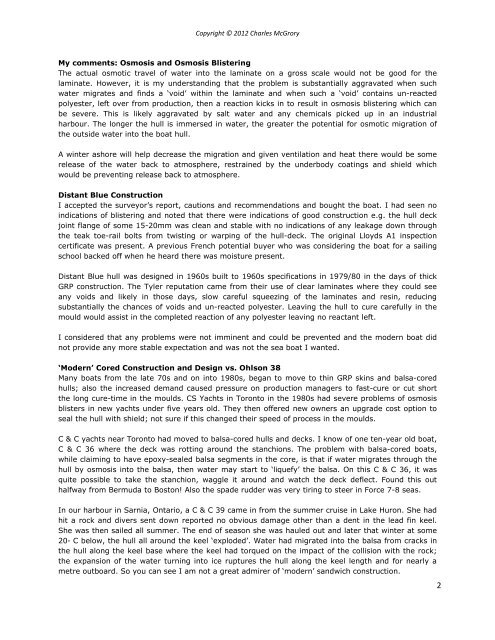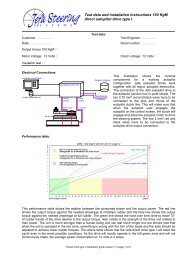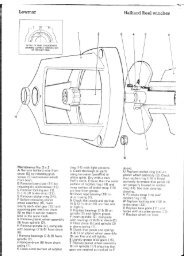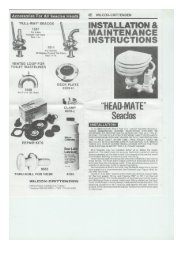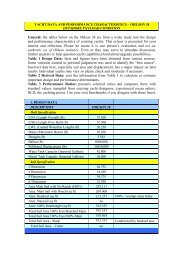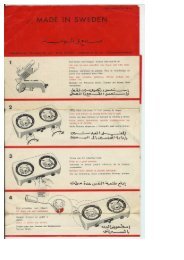You also want an ePaper? Increase the reach of your titles
YUMPU automatically turns print PDFs into web optimized ePapers that Google loves.
Copyright © 2012 Charles McGrory<br />
My comments: Osmosis and Osmosis Blistering<br />
The actual osmotic travel of water into the laminate on a gross scale would not be good for the<br />
laminate. However, it is my understanding that the problem is substantially aggravated when such<br />
water migrates and finds a ‘void’ within the laminate and when such a ‘void’ contains un-reacted<br />
polyester, left over from production, then a reaction kicks in to result in osmosis blistering which can<br />
be severe. This is likely aggravated by salt water and any chemicals picked up in an industrial<br />
harbour. The longer the hull is immersed in water, the greater the potential for osmotic migration of<br />
the outside water into the boat hull.<br />
A winter ashore will help decrease the migration and given ventilation and heat there would be some<br />
release of the water back to atmosphere, restrained by the underbody coatings and shield which<br />
would be preventing release back to atmosphere.<br />
Distant Blue Construction<br />
I accepted the surveyor’s report, cautions and recommendations and bought the boat. I had seen no<br />
indications of blistering and noted that there were indications of good construction e.g. the hull deck<br />
joint flange of some 15-20mm was clean and stable with no indications of any leakage down through<br />
the teak toe-rail bolts from twisting or warping of the hull-deck. The original Lloyds A1 inspection<br />
certificate was present. A previous French potential buyer who was considering the boat for a sailing<br />
school backed off when he heard there was moisture present.<br />
Distant Blue hull was designed in 1960s built to 1960s specifications in 1979/80 in the days of thick<br />
GRP construction. The Tyler reputation came from their use of clear laminates where they could see<br />
any voids and likely in those days, slow careful squeezing of the laminates and resin, reducing<br />
substantially the chances of voids and un-reacted polyester. Leaving the hull to cure carefully in the<br />
mould would assist in the completed reaction of any polyester leaving no reactant left.<br />
I considered that any problems were not imminent and could be prevented and the modern boat did<br />
not provide any more stable expectation and was not the sea boat I wanted.<br />
‘Modern’ Cored Construction and Design vs. <strong>Ohlson</strong> <strong>38</strong><br />
Many boats from the late 70s and on into 1980s, began to move to thin GRP skins and balsa-cored<br />
hulls; also the increased demand caused pressure on production managers to fast-cure or cut short<br />
the long cure-time in the moulds. CS Yachts in Toronto in the 1980s had severe problems of osmosis<br />
blisters in new yachts under five years old. They then offered new owners an upgrade cost option to<br />
seal the hull with shield; not sure if this changed their speed of process in the moulds.<br />
C & C yachts near Toronto had moved to balsa-cored hulls and decks. I know of one ten-year old boat,<br />
C & C 36 where the deck was rotting around the stanchions. The problem with balsa-cored boats,<br />
while claiming to have epoxy-sealed balsa segments in the core, is that if water migrates through the<br />
hull by osmosis into the balsa, then water may start to ‘liquefy’ the balsa. On this C & C 36, it was<br />
quite possible to take the stanchion, waggle it around and watch the deck deflect. Found this out<br />
halfway from Bermuda to Boston! Also the spade rudder was very tiring to steer in Force 7-8 seas.<br />
In our harbour in Sarnia, Ontario, a C & C 39 came in from the summer cruise in Lake Huron. She had<br />
hit a rock and divers sent down reported no obvious damage other than a dent in the lead fin keel.<br />
She was then sailed all summer. The end of season she was hauled out and later that winter at some<br />
20◦ C below, the hull all around the keel ‘exploded’. Water had migrated into the balsa from cracks in<br />
the hull along the keel base where the keel had torqued on the impact of the collision with the rock;<br />
the expansion of the water turning into ice ruptures the hull along the keel length and for nearly a<br />
metre outboard. So you can see I am not a great admirer of ‘modern’ sandwich construction.<br />
2


